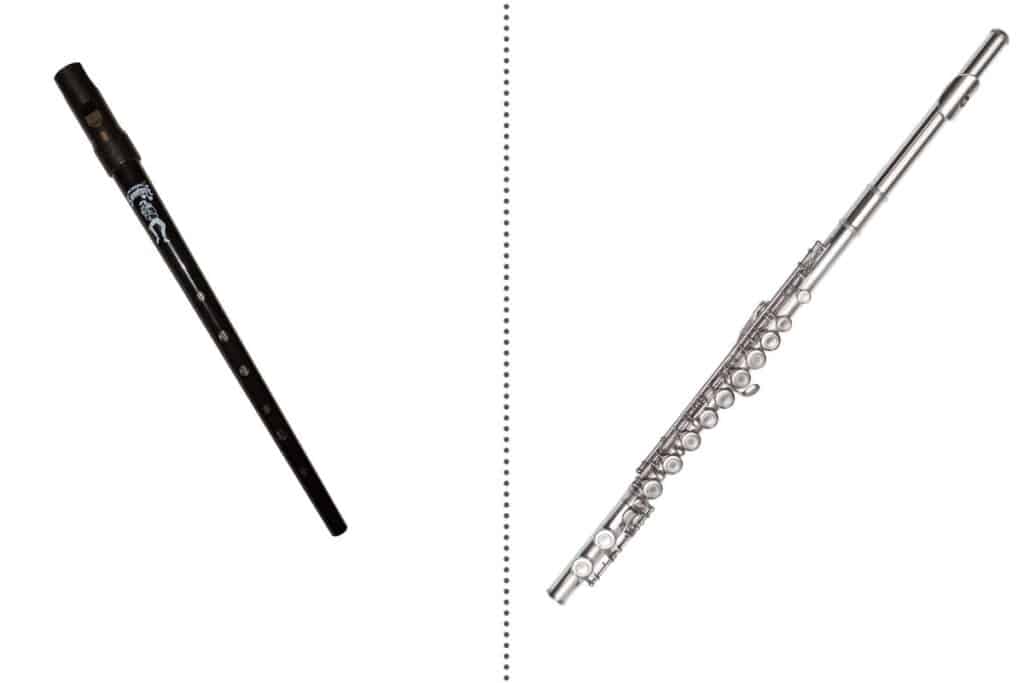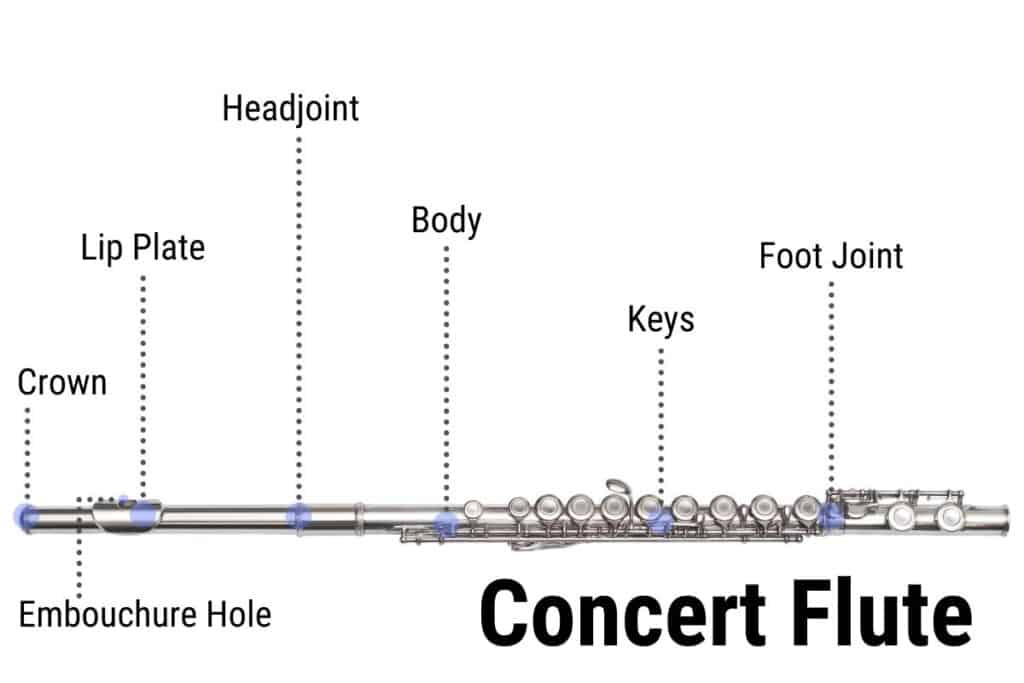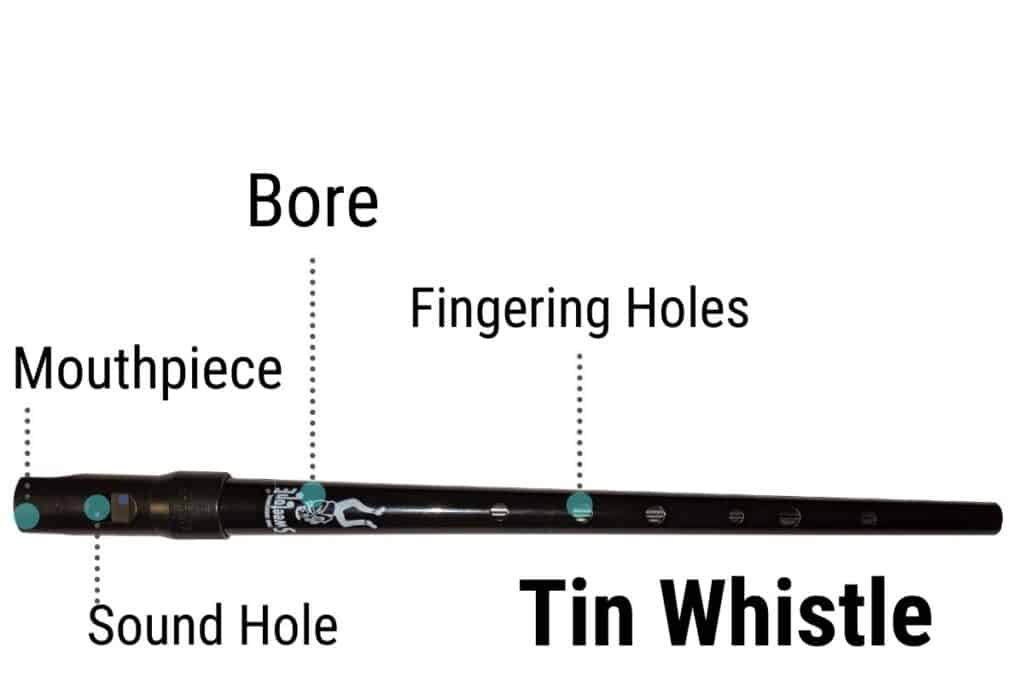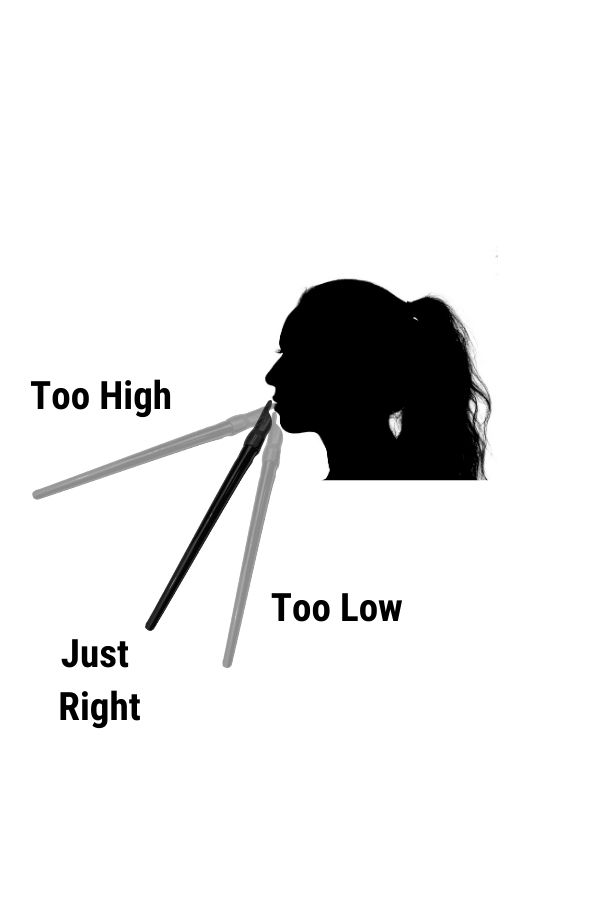This post contains affiliate links. We earn commissions if you purchase products from retailers after clicking on a link from our site. As an Amazon Associate, we earn from qualifying purchases.
There are a lot of flutes out there, and sometimes it’s difficult to keep track of which flute is what and which one do you hold sideways and which one do you play pointing forwards, etc. etc. etc. Let’s get this all straightened out!
The tin whistle is a type of fipple flute with 6 fingering holes and is designed with two open ends and is typically an end-blown instrument. The tin whistle is also designed as a diatonic instrument. The concert flute usually has 16 holes and is usually played transversely.

By the way, looking for recording equipment and musical instruments? Check out Sweetwater.com for microphones, monitors, audio interface or any other recording gear that you could ever need. (Affiliate Link)
There are lots of differences between the concert flute and the tin whistle. But it can get complicated because there are so many variations of tin whistles and even concert flutes! Let’s dive in and look at the differences in more detail so you don’t mistake the two.
Construction
The tin whistle and the flute actually are similar in some ways--they both create sound by air vibrating back and forth due to air being blown over and under a hard surface. Both concert flutes and tin whistles modify the air in the pipe by opening and closing holes along the pipe.
The concert flute and tin whistle have many other differences, size being one of the more obvious ones.
Let’s take a look at both instruments and take a look at the physical differences of the instrument.
Parts of the Flute

The concert flute visually looks much more complex with its multiple keys and the rods that the buttons manipulate to cover the tone holes.
A concert flute typically has 16 holes.
The flute comes in three major parts:
The Headjoint
The headjoint is detachable for storage purposes and can be used for tuning the instrument. If you pull out the headjoint the general pitch of the instrument will lower. On the other hand If you push the headjoint in it will make the instrument higher in pitch.
The headjoint also has a crown which caps off one end of the flute, and the embouchure hole which is surrounded by a lip plate. The lip plate serves as a resting point for the players lips and to help position the airstream into the hole at just the right angle.
The player blows air over and into the embouchure hole at a specific angle to create the sound.
The Body
The body makes up the primary length of the instrument and it has most of the holes and therefore the keys of the instrument.
The player changes the pitch of the instrument by controlling their air speed and by opening and closing the holes of the instrument by pressing the keys on the body.
The Footjoint
The footjoint has a couple holes (and therefore keys on it). It’s attached to the bottom of the flute and is aligned carefully so the player can reach the keys, properly.
Parts of the Tin Whistle

As you can see the tin whistle is much simpler. The tin whistle has 6 holes on the bore of the instrument, and there’s not much else to it. The tin whistle is often note deconstructed although more expensive tin whistles have detachable (and tunable) mouthpieces
The Mouthpiece / Fipple
The mouthpiece of a tin whistle is called a fipple (a recorder also uses a fipple. If you want to see the differences between a recorder and a tin whistle, check out our article, here) has a bit of magic to it. The flute player blows air in a very special angle into and across their embouchure hole that takes a lot of practice to perfect.
The tin whistle mouthpiece on the other hand, just requires a player to put their mouth against the mouthpiece and blow. This means that a child can easily make the tin whistle make sound within a minute.
The way this works on a tin whistle is that the mouthpiece has a special sharpened ramp that the air is directed to go over and under which creates the air vibration.
Some tin whistles mouthpieces are fixed, meaning that the pitch of the instrument is not immediately possible to adjust (without making some *cough* modifications).
The Body
The body of the instrument is literally an open pipe with 6 holes. Some tin whistle bodies are conically shaped (like the one in the above diagram), while others are cylindrical.
The tin whistle, unlike the concert flute doesn’t have any apparatus to help the player cover the holes–the player has to use their fingers to cover the holes.
Sound
Now that you’ve seen the difference between the flute and the tin whistle, let’s take a listen and see what the sound differences are between the two.
I’ll warn you, tin whistles come in a huge variety of quality and designs–so you may hear (for example) a Low D Tin Whistle which will have a sound much closer to a concert flute. Concert flutes themselves have hundreds of variations.
So what I’m going to show you are just two very common sound examples:
The flute in comparison to the tin whistle has a much richer and darker tone that feels wider. It also is capable of much lower notes in pitch than the tin whistle, with a range about B4 to F7
The tin whistle has a range of about D5 to D7, and it has a much brighter and lighter sound. It still manages to sound sweet without sounding shrill (at least the notes Mary plays don’t sound shrill).
How The Flute Is Held And Played
This is perhaps one of the more noticeable differences between the tin whistle and the concert flute.
The concert flute is played transversely, which is a fancy way of saying that the instrument is played off to the side of the player. The player uses their left hand and right hands to hold the flute somewhat parallel to the ground and to push the keys. The left hand of the flute player is closer to the player while playing.
The tin whistle on the other hand is played with the tin whistle pointing downwards and slightly forwards.
The tin whistler usually plays with their left hand on the top and their right hand on the bottom of the instrument.

Air Method (End-blown vs. Transverse)
Getting into the details a little bit of how the sound is made, the concert flute player blows across the edge and into the embouchure hole. Their lip and mouth shape (called an embouchure) is specially formed to blow a very concentrated air column.
The exact angle and speed of the air column created by the flute player is what creates the air vibration of the instrument.
The tin whistle is an end-blown flute and is much simpler to play since you just breathe into one side of the instrument and then sound is made with the help of the mouthpiece.
Another type of flute that is very similarly played to the tin whistle except is played transversely is called the Irish Flute. The Irish flute is played transversely and thus requires that special embouchure, but the fingerings and style of playing is very similar, although the sound is darker than the tin whistle.
Range
The standard D tin whistle’s lowest note is D5 and its highest note is around D7 (although you can play higher… with earplugs). This means the tin whistle’s starting note is a bit more than a full octave above the starting note of a flute.
The Bb flute plays from B4 to F7, starting an octave lower than the tin whistle.
So, all in all, the flute is designed to play more than 3 octaves, while the tin whistle is designed for about 2 octaves for most music styles.
That’s just the starting and end notes– there is a very important difference in range between the two instruments:
The tin whistle is considered a diatonic instrument, while the concert flute is considered a chromatic instrument. A diatonic instrument is only meant to play 7 notes, while a chromatic instrument can play all 12.
Since the 12 notes in our music repeat every octave, the concert flute can play more than 36 notes, while the tin whistle can play around 16.
Now, the tin whistle is designed for 7 notes, but you can play more if you use advanced techniques such as half holes. Read on to learn more about that.
Keys Vs. Tone Holes
As you saw in the above diagrams, the concert flute uses keys that are more like buttons that you press which in turn cover the holes. While the tin whistle is literally 6 holes directly in the bore of the instrument.
I should note that some high quality flutes have a hole in the middle of the keys giving the player more playing flexibility.
These keys make it easier for a new player to sound good because the holes are completely covered with the key rather than worrying about the air escaping around the edges of your finger pads (such is the case on the tin whistle).
Half Holes
One interesting benefit of not having keys to push down on the flute is that you can use a technique where you only “half” cover the holes. The word half is used roughly… you just cover the hole just enough for the note to play in tune, which could be less or more than half.
Half hole playing on the tin whistle gives you access to all 12 notes, but it is difficult to do especially when playing very quickly.
But, with half hole playing, you can do glissandos.
A glissando just means being able to bend the pitch of one note continuously until you reach your destination note. With the half hole technique, the tin whistle can bend from one note to another.
Here’s an example of this technique.
As I mentioned some concert flutes actually have openings in the keys so you can do some of these techniques as well.
Embouchure
Perhaps one of the most important differences for actually playing a tin whistle or a concert flute is the requirement of the embouchure.
The word embouchure just means the shape of the lips and mouth necessary to produce music on an instrument. Trumpet players have embouchures, saxophonists, and flute players as well as any other instrument powered by breath.
The concert flute player’s embouchure is complex and difficult to master–in fact taking years to coordinate the mouth to play incredibly complex music without squeaks and with a beautiful tone. The lips have to be focused in such a way as to allow a very thin column air to rush into and over the embouchure hole.
The concert flute player’s lips have a very small margin of error. Too little air, not enough sound–too wide an air column, no sound at all potentially. It’s one of the reasons why the flute is a difficult instrument.
This is very different from the tin whistle, because the tin whistle has a mouthpiece with a fixed ramp (called a blade, sometimes) which if you simply blow into the instrument, it will make sound.
Now, tin whistlers do have an embouchure as well. In fact it can take a long time to produce the best sound quality possible on a tin whistle. However, it’s much easier to make a good sound on a tin whistle than a concert flute. There’s more to do with proper breath support and playing technique than an embouchure for a tin whistler.
Mechanical Complexity
This is somewhat of an obvious difference, but it’s worth mentioning.
You never want to drop any instrument, even if it’s made of plastic. Accidents can happen and cracks can be made which can do a number on your sound.
The difference between dropping your concert flute vs. dropping your tin whistle is almost no comparison.
In short, a concert flute is very fragile. The joints are joined to the body with tight clearances and there is a complex apparatus that connects the keys to the sound holes through a system of levers and rods. If you bend these rods it can mean costly repairs.
A tin whistle is a hollowed out pipe with some holes in it. Although you can definitely damage the instrument if you drop it in just the wrong way, but it’s a much simpler instrument and is therefore more durable. If I was going to sail on a pirate ship I’d definitely take a tin whistle–the music style would fit better, anyway.
Cost
Another really important difference is cost. You can technically find some very inexpensive no-name brand concert flutes for under $100, but generally a “student flute” runs from $500 to $750, while a professional flute can cost well over $2000.
A beginner tin whistle that’s completely capable of beautiful music can be purchased for less than $20! Generally beginner and intermediate flutes can be purchased for under $100, while professional flutes can go up to $500-$700.
Although tin whistles are sometimes compared to concert flutes (such as in this article), concert flutes are not close to being in the same price category. If you’re interested to know what’s different between an expensive tin whistle and an inexpensive tin whistle, check out my tin whistle buying guide, here.
Usage and Playing Style
Lastly, one big difference between the concert flute and the tin whistle is what they are used for.
The tin whistle, although it has origins from several cultures, it is often associated with Irish music, and that’s where you get the term Irish tin whistle.
The tin whistle has an ancient, medieval feeling and fits extremely well in folk music. The tin whistle is used a lot in movies for this very reason (check out my post, here, for examples of some of the biggest movies of our day that have the tin whistle in it)
Irish folk music prominently features the Irish flute or the tin whistle.
The concert flute is a very versatile instrument and can be used for any genre of music, but in the traditional sense you will hear the flute in classical music, or anything that an orchestra plays. You will also hear it in jazz and pop and various other styles as well.
